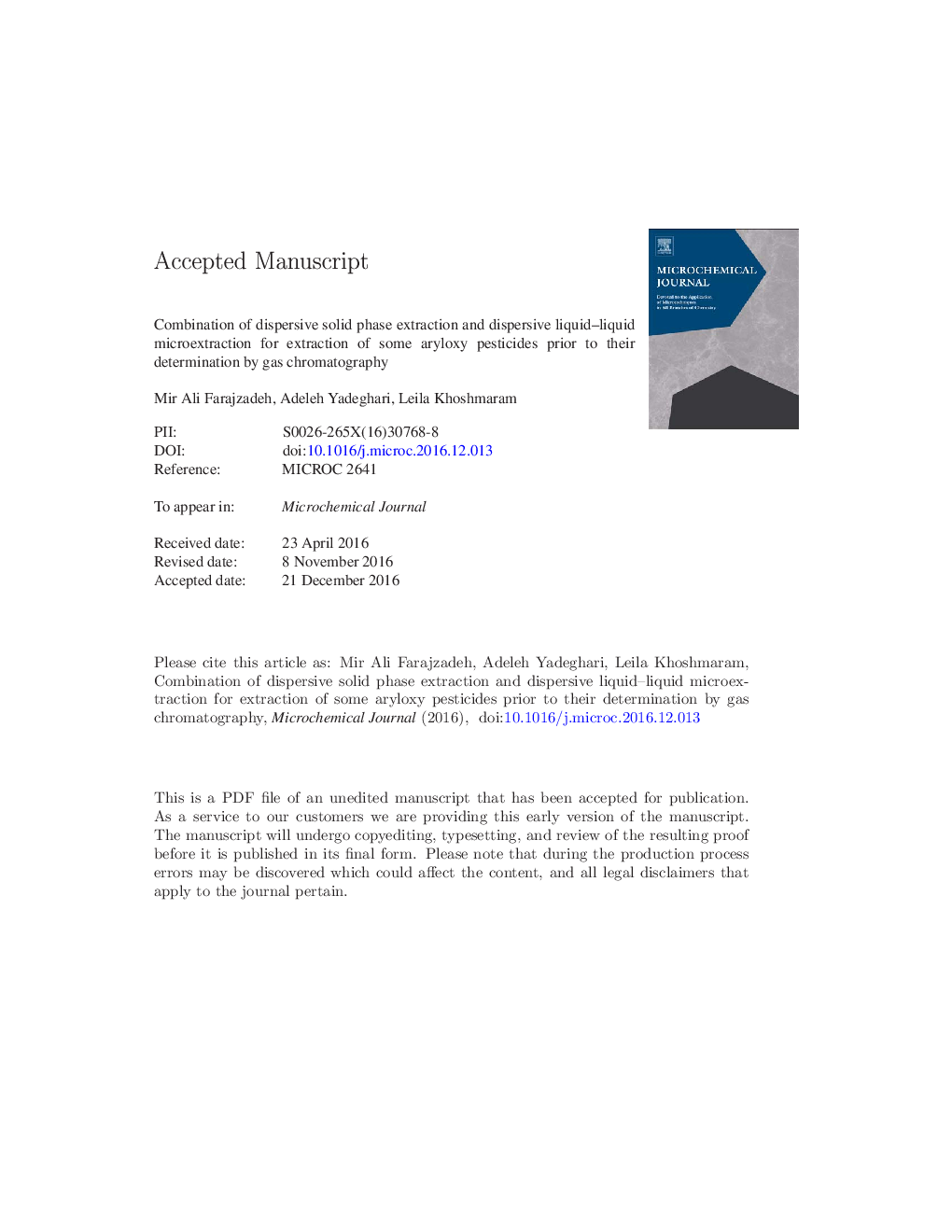| کد مقاله | کد نشریه | سال انتشار | مقاله انگلیسی | نسخه تمام متن |
|---|---|---|---|---|
| 5139270 | 1494863 | 2017 | 37 صفحه PDF | دانلود رایگان |
عنوان انگلیسی مقاله ISI
Combination of dispersive solid phase extraction and dispersive liquid-liquid microextraction for extraction of some aryloxy pesticides prior to their determination by gas chromatography
دانلود مقاله + سفارش ترجمه
دانلود مقاله ISI انگلیسی
رایگان برای ایرانیان
کلمات کلیدی
SPMELOQMSPEDSPEDLLMESPEDispersive liquid–liquid microextraction - Microextraction مایعات مایع مایعflame ionization detector - آشکارساز یونیزاسیون شعلهpesticides - آفتکشهاSample preparation - آماده سازی نمونهSolid phase extraction - استخراج فاز جامدMagnetic solid phase extraction - استخراج فاز جامد مغناطیسیdispersive solid phase extraction - استخراج فاز جامد پراکندهextraction recovery - بازیافت استخراجSolid phase microextraction - بیوفیزیک فاز جامدLOD یا Limit of detection - حد تشخیصFID - درenrichment factor - غنی سازی عاملlimit of quantification - محدودیت اندازه گیریlimit of detection - محدودیت تشخیصGas chromatography - کروماتوگرافی گازی
موضوعات مرتبط
مهندسی و علوم پایه
شیمی
شیمی آنالیزی یا شیمی تجزیه
پیش نمایش صفحه اول مقاله

چکیده انگلیسی
In this study a new version of solid phase extraction performed in a narrow-bore tube using large volume of sample followed by dispersive liquid-liquid microextraction has been proposed to achieve a high sensitive analytical method. It has been used for the extraction and preconcentration of trace concentrations of some pesticides (metalaxyl, haloxyfop-r-methyl, clodinafop-propargyl, diclofop-methyl, and bromopropylate) in different vegetables (potato, tomato, onion, garlic, celery, radish, beet, and carrot) followed by gas chromatography-flame ionization detection. In the proposed method mg-level of a sorbent (C8) is mixed with a dispersive solvent (iso-propanol) and then dispersed into an aqueous solution placed into a narrow-bore tube. By this action, the sorbent passes through the solution in a short time instead of passing the solution from the cartridge in conventional solid phase extraction in a long time. To achieve high enrichment factors, an appropriate organic solvent (acetonitrile) is used to elute the compounds of interest from the sorbent for the following dispersive liquid-liquid microextraction procedure. Some important parameters which affect the extraction efficiency were studied. Under the optimum extraction conditions, the method showed wide linear ranges (0.08-10,000 μg Lâ 1). Enrichment factors and extraction recoveries were in the ranges of 1702-4147 and 31-75%, respectively. Detection limits were in the range of 0.02-0.25 μg Lâ 1 in solution (0.01-0.89 μg kgâ 1 in samples). LOQs were obtained in the range of 0.08-0.83 μg Lâ 1 in solution (0.04-2.9 μg kgâ 1 in samples). Relative standard deviations of 4-7% (n = 6) and 2-4% (n = 7) were obtained for 10 and 50 μg Lâ 1 of each analyte, respectively. The relative recoveries obtained in three different concentrations were 80-101%.
ناشر
Database: Elsevier - ScienceDirect (ساینس دایرکت)
Journal: Microchemical Journal - Volume 131, March 2017, Pages 182-191
Journal: Microchemical Journal - Volume 131, March 2017, Pages 182-191
نویسندگان
Mir Ali Farajzadeh, Adeleh Yadeghari, Leila Khoshmaram,